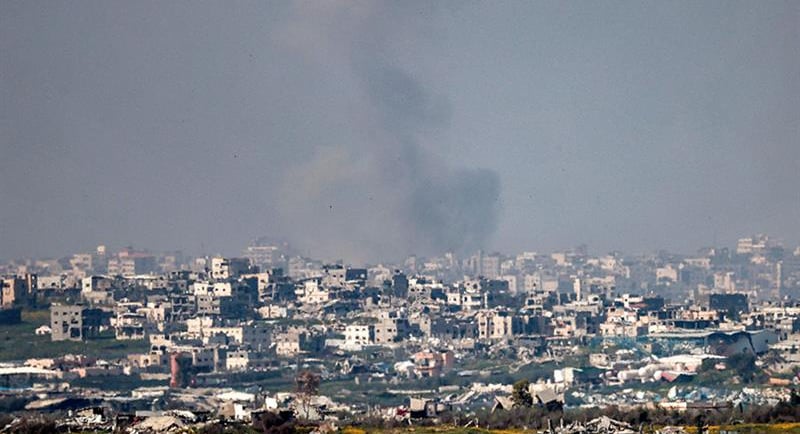Israel: 2025 Ceasefire Collapses, Israeli Military Pushes into the Levant
Israel’s resumed airstrikes in Gaza and Lebanon on March 18th have upended a tenuous ceasefire, thrusting the region into renewed uncertainty after just two months of calm. The collapse, marked by hundreds of deaths in Gaza and Israel’s bold incursions into Lebanon and Syria, underscores the fragility of peace efforts amid mutual distrust between Israel and Hamas, with Hezbollah now on edge. Will this escalation, fueled by broken hostage deals and geopolitical gambits, ignite a broader conflict involving Iran, Saudi Arabia, and their proxies, reshaping the region’s power balance?
ISRAELLEBANONPALESTINE
Raymond Puentes
3/24/20253 min read


Last week, on 18 March 2025, Israel resumed airstrikes in Gaza and Lebanon, after months-long ceasefires with both regions had expired. This development arose relatively quickly, as the 2025 ceasefire between Israel and Hamas expired on March 18th. Just hours after it ended, Israeli Prime Minister Benjamin Netanyahu announced a full-scale resumption of attacks on Gaza, warning that the initial airstrikes were “just the beginning.” An agreement that many speculated would bring an end to the conflict between Israel and Palestine has now been rendered defunct, with Israel and Hamas entrenched in their refusal to commit to peace in the region.
The 2025 Gaza war ceasefire was initially conceived as a three-step plan, agreed upon by the UN Security Council, and brokered by the United States, Egypt, and Qatar. It was meant to start with a six-week ceasefire, followed by an end to the war with Israel agreeing to withdraw from Gaza and the West Bank, culminating in a reconstruction process that would last several years. The exact terms of this proposal evolved, with Israel and Hamas eventually agreeing to a two-month ceasefire on January 19th. Both parties were then made to release hostages, despite consistent violations of the ceasefire terms by Israel and Hamas. Tensions arose due to accusations by Hamas that Israel had continued to kill Palestinians despite the terms of the ceasefire, which prompted them to violate it in turn by delaying the release of hostages. These actions led to several hundred deaths within Gaza, which only served to stoke tensions between both parties further.
Despite these matters, delibrations continued throughout the ceasefire's duration. Palestinian leaders demonstrated a willingness to enter the next phases of the original proposal but were angered by Israel's refusal to withdraw military forces from Gaza. In the following weeks, Hamas also hindered efforts of reconciliation by interfering with the return of hostages to Israel. In certain cases, they failed to return the correct deceased bodies to Israeli officials, feigning innocence under the guise of a technical mixup during the process of releasing deceased hostages to Israel. The procedures of the ceasefire were also hindered by inflammatory statements from other world leaders. In February, U.S. President Donald Trump and U.S. Secretary of State Marco Rubio were firm in their conviction, stating that the failure to return all hostages by February 15th would result in the collapse of any ceasefire deal, putting all blame on Hamas if any future conflicts arise. Comments such as these contributed to increased tensions between Israel and Hamas during the 2025 ceasefire.
The resumption of Israeli attacks on Gaza after the expiration of the 2025 ceasefire, combined with reinvigorated attacks on Lebanon as a form of retaliation against Hezbollah, have stoked great controversy as of late. Despite prior ceasefire agreements, Israel's military remains stationed in several outposts throughout Gaza, the West Bank, and southern Lebanon, all of which have seen continued airstrikes since March 18th. Many world leaders have been quick to voice their condemnation of Israel, although none have retaliated to a serious extent. These events are reflective of a broader trend in which Israel has tried to expand its influence within the Middle East, calling upon powerful allies such as the United States to aid them. While continuing airstrikes in Gaza and Lebanon, Israel's military has also made inroads into southern Syria, citing the necessity of these operations due to the collapse of the Assad regime.
Given Israel's alliance with the United States, which remains a geopolitical leader on the world stage, the implications of the 2025 ceasefire's expiration are vast. The recent military campaigns into Lebanese and Syrian territory with little resistance are completely unprecedented, leaving many to wonder how this will impact the Middle East. This could result in drastic shifts in the political dynamics of the Middle East, especially if Israel provokes countries like Iran and Saudi Arabia, powerful entities that have been known to support militaristic proxy groups throughout the Levant in the past. Increased conflicts between Israel, Saudi Arabia, and Iran could impact political relationships with Middle Eastern countries on the world stage, leaving the region fundamentally changed and scarred.
The collapse of the 2025 ceasefire underscores a slide toward militarism and instability. Israel’s actions, condemned by many, are matched by Hamas’s role in obstructing peace, resulting in a situation where both parties have played their part in making peace harder to achieve. As Israel encroaches on Palestinian, Lebanese, and Syrian territories, the risk of broader conflict looms, potentially pitting it against Iran and Saudi Arabia. Without a diplomatic breakthrough, the consequences could reverberate far beyond the Middle East, scarring the region and the world stage for years to come.


